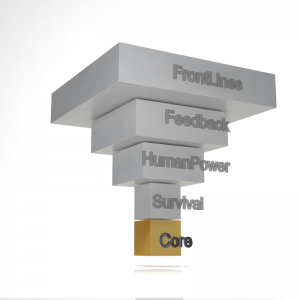Five Steps for Business Alignment

As we continue to explore the business alignment steps I listed in my June Lead Change Group column (Leadership Requires Healthy Relationships with Feedback), we’re moving from Confronting Reality to Starting on the Inside.

For any real change, you start at your core. The core alignment tools are nothing more than fundamental questions you and your team must answer. It’s those answers that foster aligned decisions and actions throughout the organization. Think of your alignment tools as levels of an inverted pyramid.
Core
Your Core is the soul of your organization. It is the intangible energy that supports and permeates through all the other levels of your business.
Examples of the types of core questions that you answer at this level of the pyramid include:
- Why does the organization exist?
- How do we expect people to behave in our organization?
- What are our core values?
- What big thing are we trying to achieve over the long term?
- What one thought should leaders in the organization always consider when they are making decisions?
- How would your employees describe your organization’s core?
Survival
While strategy can mean a lot of things, at its heart is the question, “How is the organization going to survive?”—and those answers must be in alignment with the answer to the Core questions.
Examples of Survival questions include:
- What things are critical to your success? How are you going to survive and thrive?
- What is your unique offering?
- Who is your core customer?
- How will you attract new customers? How will convince them to select your offering?
- How does your product or service make your customer’s life or job easier?
Stuck companies rarely spend time deliberately answering survival questions and often end up trying to be all things to all people, willing to do business on any terms. This creates complexity and additional costs, trapping a company within the circle of frustration.
HumanPower
Rather than “human resources,” think in terms of horsepower. Your HumanPower measures the essential brainpower to move your organization forward. This level of the alignment pyramid revolves around attracting and retaining the right people to execute the answers to Survival questions, in alignment with its Core answers.
Examples of questions associated with this tier of a core alignment tool include the following:
- How do your Core and Survival answers influence your HumanPower decisions?
- How are you going to attract and retain the best you can afford?
- Why will people want to give their best years of their life to your company?
- How will you compensate both financially and emotionally?
- What methods will you use to ensure a high percentage of good hires?
- How will you train them?
- How are you going to grow their skills?
Often, stuck companies hire whomever they can or people perceived as saviors, without a comprehensive program to orient the new hires to understand what is important for the organization’s survival.
Feedback
Feedback focuses on determining what is working or not working in your business. This level is where you start setting specific directions and objectives for the organization.
Big Feedback questions include:
- How do the Core, Survival, and HumanPower answers influence what things you need to measure and track
- What key customer and employee feedback do you need to capture and measure?
- Where is the organization generating or losing cash?
- How will you review your progress and adjust course as needed?
A key part of Feedback is measurement. Through measurement, you have accountability and are able to make rational decisions based on facts, not emotion.
FrontLines
Your FrontLines focus on how the business interacts with its customers and the outside world. This is the tactical side of the business. Stuck leaders spend most of their time on the FrontLines, since the fires are visible here.
Examples of FrontLine questions include:
- How does our core manifest itself in interactions with customers, suppliers, and other outside parties?
- What processes do we need to deliver value to customers?
- Who is responsible for specific things?
- How do we use the organization core to make these critical decisions and take action?
- How do we communicate in regular or irregular conditions?
Stuck companies struggle with defining who’s responsible for what. As a result, you see a lot of finger-pointing because people are not on the same page. People on the FrontLines get frustrated easily because they endure the daily pain of misalignment.
Aligned to Success
Once you understand your company’s alignment blueprint, and you understand how each tier of the pyramid depends on the others to remain strong and balanced, you can transform your organization into a force that confronts reality, works through challenges, and strives for new heights of success.
-END-






